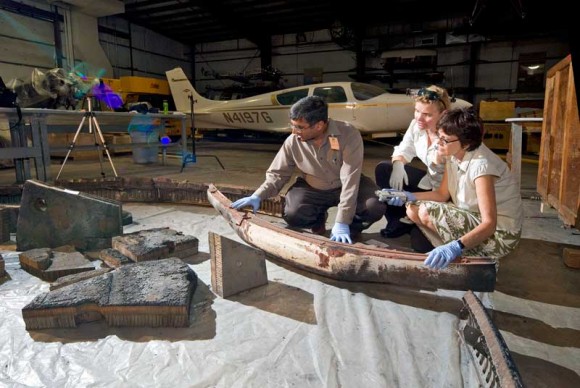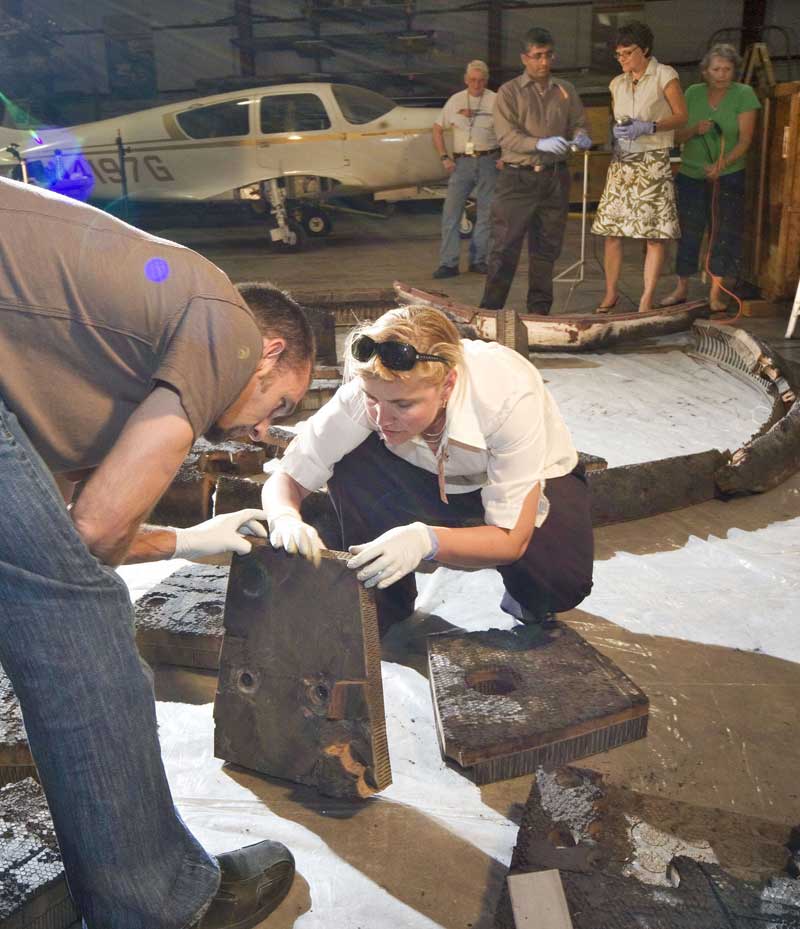[/caption]NASA scientists currently working on the Orion Crew Exploration Vehicle had the rare opportunity to unpack a little piece of history. A visit to Smithsonian Institution’s National Air and Space Museum led them to uncover crates containing the heat shields used during the development of the Apollo Program, some 35 years ago. The shielding has not seen light of day since 1966 when it was dropped from low Earth orbit and protected a test vehicle from fiery re-entry. The NASA scientists hope to learn more about the thermal response of the old heat shield to improve the shielding of the Orion return vessel a whole generation after the pioneering lunar missions…
On July 31st and August 1st, the NASA crew descended on Smithsonian Institution’s National Air and Space Museum Garber Facility to do a bit of space-age archaeology. The facility makes it their job to collect, preserve and restore anything space and aircraft related, ensuring the Apollo heatshieilds were in perfect condition (or as “perfect” as they can be after undergoing re-entry over three decades ago) for the Orion development teams from NASA’s Goddard Space Flight Center in Greenbelt, Maryland, and NASA Ames Research Center, Moffett Field, California. What they unpacked was a space geek’s dream.
“We started working together at the end of June to track down any Apollo-era heat shields that they had in storage,” said Elizabeth Pugel from the Detector Systems Branch at Goddard. “We located one and opened it. It was like a nerd Christmas for us!”

The NASA team managed to eventually track down heat shield material from a test re-entry from low Earth orbit on August 26th, 1966. This material will prove useful in the continuing development of the Constellation Program’s Orion Crew Exploration Vehicle so more information can be gained about the material’s reaction to extreme heat as it was dropped through the atmosphere.
“We are examining the design of the carrier structure (the metal structure that connects the heat shield to the vessel that contains the astronauts) and the heat shield material’s thermal response,” Pugel added.
“The Smithsonian has been generous in their providing large pieces of the heat shield that we will be doing destructive and non-destructive testing on during the months before Orion’s Preliminary Design Review,” said Matthew Gasch from NASA Ames. “This information will further our confidence in our design and materials development.”
It might seem strange that NASA scientists are researching re-entry technology from the Apollo era, after all the Orion cone-like design borrows its shape from the Apollo Program’s Saturn V Command Module (amongst others), but that is where the 20th century similarity ends. Orion will be packed with the most advanced 21st century computing, electronics, life support, propulsion and heat protection systems.
Orion aside, I would have loved to have been there when the NASA Orion scientists cracked open the wooden Apollo crates (using crowbars, naturally), to find them filled with the dusty artefacts from the beginning of the space age (but then again, I might be watching way too much Indiana Jones movies…).
Source: NASA


Question: I feel this is kind of unnecessary. Was there no notes of previous experiment? Was the work, during the Apollo era, forgotten and undocumented?
@NOBody: The trouble with documentation, is that if the original documentation lacks something, then they have no idea what that something is. Having something you can touch and do tests on ,tests they may not have had at the time of documentation, allows more data to be collected. Documentation lacks the resolution of the real deal, as it were.
It’s pretty sad that NASA has to reverse engineer 40 year old technology.
I believe that at the time, the heatshields where designed to do the job with adequat margins – and it did.
What the researchers are most likely looking at now is how did the shields actually perform, any cracks, melting, anything that can bring clues for further improvements.
Hypothetically, doubling performance can be interpreted in atleast two ways – reduce the weight to half with same performance, or double the amount of heat.damage the shield can take with the same weight. Both are ways to improve, and thats where the old shields can add input i believe.
This is good.
TO NObody:
Great deal of engineering new technology is first proving it will not fail, second if it fails improve it, and third keep improving and prove it won’t fail again.
There is no better way to do this than by checking upon old technology that precedes the new one.
To further what The Occupant said I’m sure there has been developments in materials science and engineering that would allow examinations and tests on this material what wasn’t available to the engineers 40 years ago.
Ah. I forgot about that. Yeah, I bet the thing is that the previous test or actual items may not be examined the way we can do now, (with better technology).
Although, I like the idea of returning to the Moon. I feel somewhat sadden that we returned to the capsule setup. I would like to see a real space plane.
Thanks,
In the words of the great Motown singers: “Ain’t nothin’ like the real thing, baby!”
You can have all the documentation and blueprints you want, but handling it…that’s a whole other reality.
If proven old technology does the job as required, there is no need to develop something better, and there is no need to spend money on research on something better. That is not the type of situation which companies and institutions like who make a living on doing research and to provide a useful result.
Blueprints are not of much use if the materials used in the systems of which you have a blueprint are not available any more, and if the people who built and processed these materials and built the system are dead and gone, and the background documentation has got lost during with the passing time. You simply can´t keep records on everything forever.
600.000 people worked in and for the Apollo program. The combined skills, the knowledge and experience of these people was necessary to make the flight to the moon a success. Even if you have the blueprint on your table, you won´t find that it has the knowledge and experience of these people atached to it.
Therefore, even the blueprints of the Saturn V were destroyed deliberately some decades ago, as the responsible managers concluded that this rocket will never be built again.
Without the technical documentation records which might hold information on where samples of tested Apollo heatshields were kept, it is impossible to learn that these samples exist. I think it is a matter of real luck that they were discovered.
Regards,
Günther
We just today had two wood pallets marked NASA and APOLLO come through our plant. They now contain tasty Prairie Farms frozen yogurt like substance half gallons. Just did a little research and found this article.